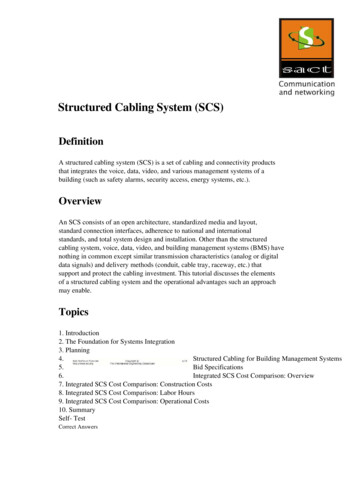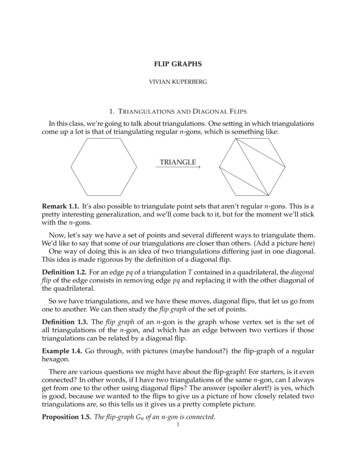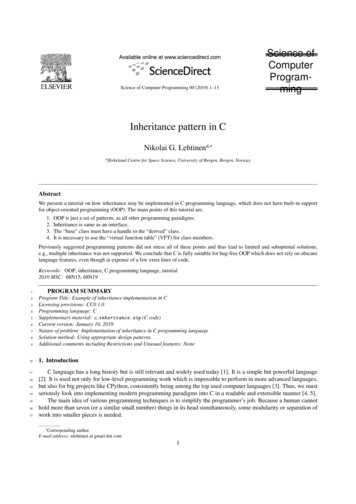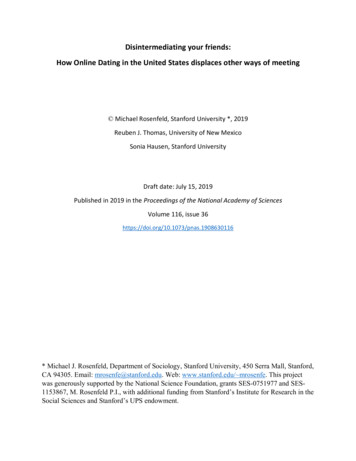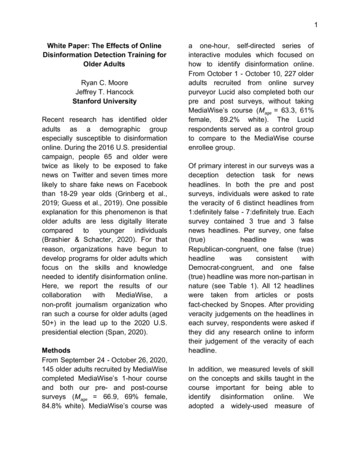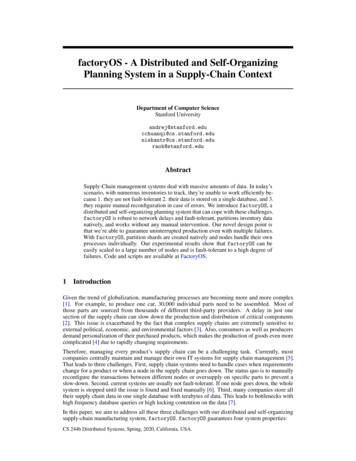
Transcription
factoryOS - A Distributed and Self-OrganizingPlanning System in a Supply-Chain ContextDepartment of Computer ScienceStanford ctSupply-Chain management systems deal with massive amounts of data. In today’sscenario, with numerous inventories to track, they’re unable to work efficiently because 1. they are not fault-tolerant 2. their data is stored on a single database, and 3.they require manual reconfiguration in case of errors. We introduce factoryOS, adistributed and self-organizing planning system that can cope with these challenges.factoryOS is robust to network delays and fault-tolerant, partitions inventory datanatively, and works without any manual intervention. Our novel design point isthat we’re able to guarantee uninterrupted production even with multiple failures.With factoryOS, partition shards are created natively and nodes handle their ownprocesses individually. Our experimental results show that factoryOS can beeasily scaled to a large number of nodes and is fault-tolerant to a high degree offailures. Code and scripts are available at FactoryOS.1IntroductionGiven the trend of globalization, manufacturing processes are becoming more and more complex[1]. For example, to produce one car, 30,000 individual parts need to be assembled. Most ofthose parts are sourced from thousands of different third-party providers. A delay in just onesection of the supply chain can slow down the production and distribution of critical components[2]. This issue is exacerbated by the fact that complex supply chains are extremely sensitive toexternal political, economic, and environmental factors [3]. Also, consumers as well as producersdemand personalization of their purchased products, which makes the production of goods even morecomplicated [4] due to rapidly changing requirements.Therefore, managing every product’s supply chain can be a challenging task. Currently, mostcompanies centrally maintain and manage their own IT systems for supply chain management [5].That leads to three challenges. First, supply chain systems need to handle cases when requirementschange for a product or when a node in the supply chain goes down. The status quo is to manuallyreconfigure the transactions between different nodes or oversupply on specific parts to prevent aslow-down. Second, current systems are usually not fault-tolerant. If one node goes down, the wholesystem is stopped until the issue is found and fixed manually [6]. Third, many companies store alltheir supply chain data in one single database with terabytes of data. This leads to bottlenecks withhigh frequency database queries or high locking contention on the data [7].In this paper, we aim to address all these three challenges with our distributed and self-organizingsupply-chain manufacturing system, factoryOS. factoryOS guarantees four system properties:CS 244b Distributed Systems, Spring, 2020, California, USA.
1. Robustness to network delays: The system is able to continue manufacturing even if thereare network delays.2. Fault-Tolerance to node crashes: The system is fault-tolerant by making nodes onlydepend on their neighbors. Even if the leader node crashes, nodes continue production whilea new leader is being elected.3. Native Inventory Partitioning: Instead of having a large database of inventory history,each individual node manages its own inventory data. Also, there is no need for a cleveralgorithm to partition shards; the shards are created natively.4. Uninterrupted Production without manual intervention: factoryOS dynamically findsviable flows in case a node crashes or if requirements for a node change.2Related WorkSupply Chain Networks are often modeled and analyzed using Petri nets and we use simplifiedversion of Petri Nets which can be extended with more stochastic characteristics of supply chains[8][9]. A multi-agent based approach is proposed to enable manufacturing systems to make fast andfrequent reconfiguration of the production systems [10]. Latest work in this area is Token-flow SupplyChains: the Colored Petri-nets model of digital supply chain resolves the limitation of Petri-netsto achieve the distinctness of markings, and "Distributed Leger System" manages all supply chaintransactions and digital events. With DLSs, each transactions are verified by a consensus of the DLSs’participating nodes, once the consensus is reached and stored in all participating nodes, thus it solvesthe limitation of single point of failure of centralized leger system. In contrast, our distributed systemautomatically elects a central leader. This leader makes optimal decisions of how to reconfigure thesupply flow globally in case a node fails.There are similarities between our system and Apache Kafka [11]. Both systems are structured inclusters with producer and consumer APIs. However, in Kafka’s case, the sender can send messagesto Kafka, while the recipient gets messages from the stream published by Kafka. Kafka acts as acentral distributor. In our case, sender and recipients communicate directly with each other and oursystem only steps in when the current flow needs to be changed.33.1Proposed ApproachOverviewThis section covers the design of factoryOS and its components. A production system in factoryOSconsists of a set of nodes. We assume the existence of a fixed set of item types. Each node representsa stage in the system consisting of the possible consumed and produced items within the supplychain. There can be different producers of the same item type in our system, this is key in order tosupport uninterrupted flow of production. Each node has a certain node-ID and needs certain itemsas input requirements to be able to produce a resulting item. This dependency between two nodescan be represented as an edge in the DAG. During initialization, we reach consensus on a possiblesupply-chain flow. The agreed upon supply-chain flow can also be represented as a DAG. We’ll goover each component in detail in the following sections.An item requirement consists of a quantity and an item type. To take a simple example, a snippet of awindow production supply chain is show in Figure 1. A node with node-ID 1 needs three items oftype wood to produce five items of type window frame. A node with node-ID 2 needs two items oftype window frame to produce one item of type window. The actual production flow is computed byFigure 1: Snippet of a Window Production Supply Chaina leader node and stored in a globally accessible way. During production, nodes query the flow toidentify from which specific nodes they should supply items and to which nodes they should send the2
resulting items. In this way, each participating node in factoryOS knows only about its neighborsand the leader. Hence, each stage is responsible for making manufacturing decisions based on thelimited information the leader provides to the node instead of attempting to store and process the fullsupply-chain state in a central data store. All communication that is required for production takesplace on a node-to-node basis without any leader participation.By localizing the manufacturing decisions, factoryOS guarantees three out of its four systemproperties. First, the localization increases the robustness of the supply-chain management systemand ensures fault-tolerance. Each node in the supply-chain can crash, be delayed or be paused, for e.g.maintenance, without having to halt the entire supply-chain. This is a core improvement to traditionalsystems where an unavailable database can halt an entire factory. We’ll elaborate on this in Section3.3.5. Second, localizing manufacturing processes reduces the dependency of having “fat servers”that need to be scaled vertically in storage and computation as the system state increases in size.factoryOS makes each individual node manage its incoming inventory without a clever algorithm topartition shards since the shards are created natively.3.2FlowA crucial concept used by factoryOS is the concept of flow. The flow represents the up-to-datequantities and types of items being exchanged between the stages in the system. Extending theprevious example in Figure 2, a stage can “list” itself as a node that can supply a batch of up tofive frames. The downstream node does not need to consume all five frames. The flow in this casewill be set to 2 out of 5. The flow does not translate to the actual requirements of the item beingmanufactured. It determines the batch sizes that the nodes are willing to exchange. So, the stageproducing windows might request frames every 30 minutes but output a window every 2 hours. Thatdecision is left up to the stage. After the leader has computed the flow and stored its instructions in aFigure 2: Flow between two nodesglobally accessible way, factoryOS establishes the contract between the stages. It is left up to thenodes to enforce the contract. In figure 2, the frame stage is free to deny a request from the windowstage if a batch of frames is not ready. In that case, the window stage is free to go back to the Leaderand ask for the flow to be adjusted or retry at a later point.3.3Implementation DetailsBefore diving into the operations that can be performed by factoryOS, see figure 3 that outlines allthe essential components of the system. Our implementation is based on Python where we extensivelyuse Threads and Processes to simulate a geo-distributed cluster. We briefly go over the involvedcomponents in the following sections.3.3.1Subscriber and PublisherA cluster consists of different nodes, i.e. supply chain stages, that bind to a specific port. Each nodeis a process that has a subscriber and publisher thread, which it uses to communicate with othernodes. The publisher can broadcast messages or send them to specific nodes. The subscriber threadconsumes the messages and triggers a callback in the stage or heartbeat routines.3.3.2LeaderOne node takes the role of a leader. Only the leader has the ability to compute and manipulate theflow. We used a recursive, depth-first-search algorithm with memoization that starts at the end nodeand traverses through nodes until it finds a viable path to reach the start node. This allows factoryOSto dynamically find viable flows in case a node crashes or if requirements for a node change. Theleader is elected through system file locks but can also be determined through services such as a3
Figure 3: Implementation of factoryOS where each node is a Python process using the file systemas configuration storageconfiguration management service such as Zookeeper. In case the leader fails, we reelect the leaderonce nodes detect the death through heartbeats.3.3.3HeartbeatsEach node also contains a heartbeat thread. Heartbeats are purely neighbor-based. This means that theheartbeat thread uses the globally accessible flow graph and sends/receives heartbeats only to/fromnodes it trades parts with. This drastically reduces the number of messages exchanged within thecluster. Heartbeats are used to detect crashes. For example, if a node does not receive a message froma neighbor within a certain time range, the leader gets notified by the heartbeat thread and promptedto recompute the flow. This means that only the node’s neighbors are a candidates for crash detection.3.3.4StageThe Stage routine is responsible for producing, requesting and sending batches of items. Stage usesdifferent forms of signals to keep track of inventory. Every stage contains an inbound and outboundqueue of items, i.e. batches items that are ready to be consumed and sent respectively. These batchesare marked with a "in-queue" flag in the write-ahead log (WAL) in both the sending and receivingnode once the trade has occured.To receive a certain item, a stage sends a RequestBatch to a valid neighboring upstream node. Theneighboring node can either send the item batch (denoted by a BatchSent) or respond that the itembatch is not available (denoted by a BatchUnavailable). In case the neighbor sends the batch, theflag of this batch changes to “in-transit” in the WALs of both nodes. The downstream node also sendsa WaitingForBatch as an acknowledgement of the trade being commited. When the batch getsdelivered downstream, the receiving stage sends a DeliveryConfirmed message to the upstreamneighbor and the batch flag changes to “delivered” in the upstream node’s WAL (and “in-queue” inthe downstream node’s WAL. Once the batch is consumed by the downstream node, i.e. used toproduce a certain item batch, the flag of the item batch changes to “consumed” in the WAL.Using inbound queues makes factoryOS resistant to crashes and network delays. As long as thereare items in the queue, the stage can keep producing without interruption. Knowing this, the node’sparameter can be tuned to keep a certain of buffer of inventory in case of a choppy network. Ifneighboring nodes delay sending batches of item, nodes can bulk order items. As soon as the networkgets better, the node can go back to non-bulk orders.3.3.5Stage RecoveryThe stage thread stores all its operations in a WAL to support recovery. Every time a batch changesits status, e.g. from delivered to consumed, the stage routine persists this change in its WAL. In thecase a node crashes and gets back into the flow, the stage thread will try to recover the in-queue andin-transit batches by restoring it from the WAL. In case a batch was in transit, the recovered nodere-sends the a message to the downstream node and the downstream node will reply with a delivery4
confirmation in case the batch was already delivered. If it was not delivered, the down stream willrespond with a WaitingForBatch which will re-assert that the batch is in transit.It is import to observe that the state of a batch is sequential, i.e. in-queue in the upstream node,in-transit in both nodes and then in-queue and delivered in the downstream and upstreamnode respectively. Therefore, any two nodes can agree on the state of the batch by picking the stagethat is later in the before mentioned order.3.3.6Operations RunnerAn operations runner thread exists in every node. Operations are different from messages exchangedbetween nodes. Their primary usage is to manually instruct a node to commit an action using anexternal client from the main thread. Operations runner is exclusively for experimentation purposes,where we require execution of multiple randomized operations e.g. Crashes, Recoveries, Updates.3.3.7Configuration StorageConfiguration in this case refers the potential inbound and outbound edges of a node, the flowrepresented as a DAG of active edges, the current leader. Since this information should be eventuallyconsistent across all nodes, any distributed storage system that scales well for a high frequency ofreads on graph like data will suffice. For example, neo4j paired with Zookeeper for leader election.Our implementation used atomic file storage with serialised Python objects given all nodes sharedthe file system. Our configuration management APIs are designed in a way which makes it easy toplugin popular services such as Zookeeper without any intrusive changes.3.4OperationsUsing the described implementation of factoryOS, we can perform multiple scenarios within thesupply chain context. factoryOS supports node crashes, addition of nodes, requirement changes ona node level, and live production rerouting in case a node has a maintenance operation. Given supplychains are extremely fragile, factoryOS removes the challenge of interruptions during production.In short, we’ll explain the node crash scenario using the example in figure 4. In case a node crashes,Figure 4: Implementation of factoryOSone of its neighbors will detect that it doesn’t receive any heartbeat messages from the crashed node.Due to lack of heartbeats, the neighbor will inform the leader that the crashed node is dead (1). Theleader will recompute the flow and update it in the globally accessible file storage (2). Once that isdone, the neighbors begin using the new flow. It is important to restate that all non-neighboring nodesare still able to continue with production. All neighboring nodes dependent on the crashed node arealso able to continue in case they have enough batches of items produced by the crashed node in theirinventory.5
4ExperimentsWe model supply chains with two parameters: N and T , where N (number of nodes in active flow)is the depth of the supply chains and T is the number of alternative suppliers per product type.To validate the system’s fault tolerance, we randomly kill nodes and then recover them. The failurerate is defined as number of failure nodes per minutes and recover rate is defined as number of nodesto be recovered in the simulation.We use Dual Xeon Gold 6130 CPU with total 64 cores to run factoryOS simulation. And thesimulation is run for 10 minutes for all size of supply chains.4.1Performance MetricsMetrics that determine the efficiency/scale of the system include:1. Successful Manufacture Cycles: Per node average of number of manufacturing cycles inwhich a stage was able to successfully produce. A cycle includes consuming a item from allthe inbound queues and producing one batch of the resulting item.2. Messages received and sent: Per node average of the number of messages sent and received.3. Heartbeats Per node average of the number of heartbeat requests, responses sent andreceived.4.2EvaluationRefer to Figure 5 6 for the simulation of different size of factoryOS, it demonstrates that thefactoryOS is scalable to all size of global supply chains. But as N increases, total messages sentand received grow, heartbeat messages (sent and received) grow, as a result the overall CPU usagesand memory consumption increases to exhaust our hardware, slowing response to heartbeat causesneighbour nodes’ false report to leader about the death of nodes, leader reconfigure the flow. As aresult, the percentage of successful manufacturing cycle over total cycle decreases.Figure 5: factoryOS scalability5ConclusionRefer to Figure 7, this experiments demonstrates that factoryOS is able to detect the dead nodesand reconfigure the manufacturing flow using alternative suppliers. And it’s robust to maintaining thesuccessful manufacturing cycles even the rate of node crashes increases.6
Figure 6: factoryOS scalabilityFigure 7: factoryOS fault tolerance6Future WorkIn the future, we want to extend our solution and include ZooKeeper for coordinating a distributedconfiguration storage. Also, we plan to add proper leader election using Raft. Lastly, we strive to testour system across multiple machines and networks to analyze our performance in a more realisticsetting.7
References[1] Saveen A Abeyratne and Radmehr Monfared. Blockchain ready manufacturing supply chainusing distributed ledger. 9 2016.[2] Alan Punter. Supply Chain Failures. 2013.[3] Tim Conor. Still waiting for nike to do it. 2001.[4] Marc Poulin, Benoit Montreuil, and Alain Martel. Implications of personalization offers ondemand and supply network design: A case from the golf club industry. European Journal ofOperational Research, 169(3):996 – 1009, 2006.[5] Zhimin Gao, Lei Xu, Lin Chen, Xi Zhao, Yang Lu, and Weidong Shi. Coc: A unified distributedledger based supply chain management system. Journal of Computer Science and Technology,33(2):237–248, 2018.[6] Christopher Reining, Omar Bousbiba, Svenja Jungen, and Michael Ten Hompel. Data miningand fault tolerance in warehousing. In Wolfgang Kersten, Thorsten Blecker, and Christian M.Ringle, editors, Digitalization in Supply Chain Management and Logistics: Smart and DigitalSolutions for an Industry 4.0 Environment. Proceedings of the Hamburg Inter, volume 23 ofChapters from the Proceedings of the Hamburg International Conference of Logistics (HICL),pages 215–232. Hamburg University of Technology (TUHH), Institute of Business Logisticsand General Management, 2017.[7] Ome
raok@stanford.edu Abstract Supply-Chain management systems deal with massive amounts of data. In today’s scenario, with numerous inventories to track, they’re unable to work efficiently be-cause 1. they are not fault-tole


